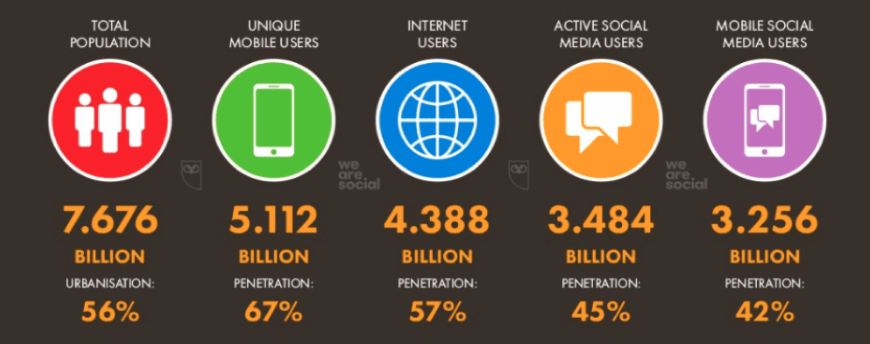The rapid evolution of technology has tremendously shifted the marketing environment. New media platforms are constantly emerging, all to involve, connecting with, and engaging consumers. As a result, the digitalization of the marketing landscape has shifted the consumer-marketer relationship, and consequently, diffused into interactive media, thereby changing the concept of advertising (Appel et al., 2020). Furthermore, these technological advancements and active internet usage have led to the shoppers gaining more control regarding the information they receive and how they choose to apply that information (Kumar, Choi and Greene, 2017). Therefore, this has created a two-way relationship between consumers in the marketplace and brands.
Understanding the consumers’ perception towards advertising is critical for businesses since the way that it is perceived influences its success. Advertising on social media sites is one of the most popular promotional techniques embraced in the current business world. Social media has the highest proportion of consumers (Kelly et al., 2019). It is estimated that as of 2019, there were approximately 3.484 billion social media users globally, which is equivalent to 45% of the total world population (Appel. et al., 2020).

Initially, it existed as a public platform for selfies and posts, however, it has evolved into a multi-faceted environment within with companies can stimulate two-way conversations with consumers and perform targeted promotional marketing campaigns. Facebook is considered as the most popular platform with the greatest daily engagement rates and a higher user base.

Using such platforms to create or promote brand awareness should be planned efficiently. A wrong approach can significantly harm a brand. Therefore, consumers’ perceptions should be comprehensively evaluated when companies intend on receiving the positive impacts of advertising (Chang et al., 2019; Martin, Borah and Palmatier, 2017).
The practice of Behavioral Targeting (BT), also known as online behavioral advertising, has materialized as a new tool for marketers to effectively and efficiently monitor online consumer behavior and execute targeted marketing offers to them (Wiese and Akareem, 2020). BT functioning relies on creating profiles for consumers’ online activities, for instance, their browsing habits and frequency of visiting websites (Kakatkar and Spann, 2018). This information is later used to leverage past consumer behavior to influence and predict their future behavior.
However, although the brand has an opportunity to reach a larger audience, a new trend is adversely impacting the audience base. There has been an emergence of data privacy issues (Gupta and Dhami, 2015; Zhang et al., 2017). It is essential to note that personalization depends on two primary factors: the ability of the marketer to obtain and process consumer data and the willingness of the consumers to share this information and utilize personalization services (Chung, Wedel and Rust, 2016).
Consequentially, privacy and personalization can be discorded; a phenomenon referred to as the Personalization-Privacy Paradox (Aguirre et al., 2015).
Several studies have revealed that most people are becoming cynical about sharing personal data (Haenlein, 2017; Herhausen et al., 2019; Kerr and Drennan, 2016). This is because digital marketing, regardless of the type, depends on the element of trust between consumers and brands. Furthermore, most, if not all, online promotions require participants to submit some form of personal information (Liam, Previte and Coote, 2020). Most research has focused on the interrelationship between consumers and privacy concerns, and few have included the aspect of the brand in the equation regarding image and strength (Martin and Murphy, 2017).
References
Aguirre, E. et al. (2015). ‘Unraveling the personalization paradox: The effect of information collection and trust-building strategies on online advertisement effectiveness’, Journal of Retailing, 91(1), pp. 34-59.
Allen, R. (2020). ‘Social media marketing trends 2020’, Smart Insights.
Appel, G. et al. (2020). ‘The future of social media in marketing’, Journal of the Academy of Marketing Science, 48, pp. 79-95.
Chang, Y. et al. (2019). ‘Getting more likes: The impact of narrative person and brand image on customer-brand interactions’, Journal of the Academy of Marketing Science, 47, pp. 1027–1045.
Chung, T. S., Wedel, M. and Rust, R. (2016). ‘Adaptive personalization using social networks’, Journal of the Academy of Marketing Science, 44, pp. 66-87.
Gupta, A. and Dhami, A. (2015). ‘Measuring the impact of security, trust and privacy in information sharing: A study on social networking sites’, Journal of Direct, Data and Digital Marketing Practice, 17, pp. 43-53.
Haenlein, M. (2017). ‘How to date your clients in the 21st century: Challenges in managing customer relationships in today’s world’, Business Horizons, 60(5), pp. 577-586.
Herhausen, D. et al. (2019). ‘Detecting, preventing, and mitigating online firestorms in brand communities’, Journal of Marketing, 83(3), pp. 1-21.
Kakatkar, C. and Spann, M. (2018). ‘Marketing analytics using anonymized and fragmented tracking data’, International Journal of Research in Marketing, 36(1), pp. 117–136.
Kelly, L. et al. (2019). ’Feel, think, avoid: Testing a new model of advertising avoidance’, Journal of Marketing Communications, 0(0), pp.1-22.
Kerr, G. and Drennan, J. (2016). ‘Privacy concerns on social networking sites: A longitudinal study’, Journal of Marketing Management, 33(17), pp. 1465-1489.
Kumar, V., Choi, J. B. and Greene, M. (2017). ‘Synergistic effects of social media and traditional marketing on brand sales: Capturing the time-varying effects’, Journal of the Academy of Marketing Science, 45(2), pp. 268-288.
Llewellyn, G. (2019). ‘Social commerce trends for 2020 you need to look out for’. Smart Insights.
Liam, P., Previte, J. and Coote, L. (2020). ’Beyond concern: socio-demographic and attitudinal influences on privacy and disclosure choices’, Journal of Marketing Management, 36(5-6), pp.519-549.
Martin, K. and Murphy, P. (2017). ‘The role of data privacy in marketing’, Journal of the Academy of Marketing Science, 45(2), pp. 135-155.
Martin, K., Borah, A. and Palmatier, R. (2017). ‘Data privacy: Effects on customer and firm performance’, Journal of Marketing, 81(1), pp. 36-58.
Wiese, M. and Akareem, H. (2020). ’Determining perceptions, attitudes and behaviour towards social network site advertising in a three-country context’, Journal of Marketing Management, 36(5-6), pp. 420-455.
Zhang, Y. et al. (2017). Online shopping and social media: Friends or foes? Journal of Marketing, 81(6), pp. 24–41.

